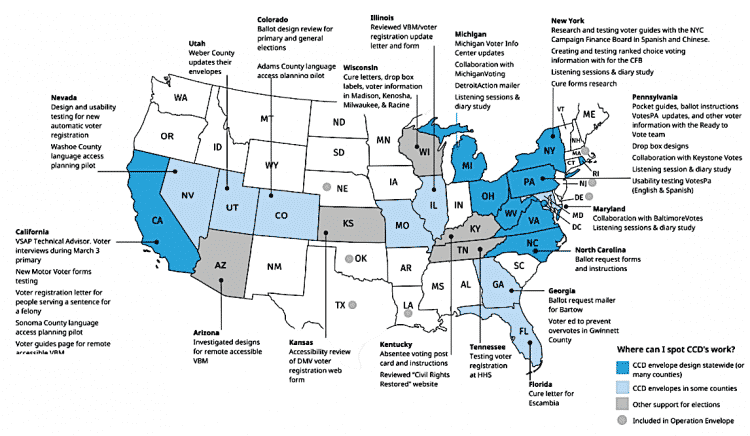In Lansing, Mich., the elections department used its $443,000 grant to buy more absentee ballot drop boxes and mail absentee ballot applications to every registered voter.
In Georgia, the grants were used to expand curbside voting and conduct “the necessary voter outreach … to promote absentee voting and encourage higher percentages of our electors to vote absentee,” according to a grant application.
Documents inspected by RealClearInvestigations also showed:
- In Lowndes County, Ga., CTCL grant money was used to pay $15,000 in attorney fees through June. A county elections official told RCI that the money was paid to lawyers handling public records requests stemming from the elections, a process that she expects will last into the summer.
- CTCL was “very lenient regarding what we could spend the money on,” Deb Cox, Lowndes County elections supervisor, said. “They put virtually no restrictions on it as long as it relates to the election.”
- Mahoning County, Ohio, spent $3,500 on a student to monitor Twitter and Facebook and “report any bad actors that may want to disrupt our operations,” one local official stated in its grant report. Grant money was also spent to produce a training video for elections workers.
- Election officials in Lorain County, Ohio, paid an $8,100 Verizon bill and spent $24,000 on a van at a local car dealership. The van was used to transport equipment between a warehouse and the elections department, an elections official told RCI.
- In Boone County, Mo., the elections department used $3,000 of the COVID grant to make a rap video and buy radio spots. “We did a rap video to appeal to younger, first-time voters,” Brianna Lennon, Boone County clerk, said. “We wanted to keep it popular in a format that would have the most appeal to young voters. “
Elections departments received millions of extra dollars in federal aid in 2020, including $400 million in CARES Act funding and $425 million in federal Help America Vote Act grants.
Despite the influx of public money, elections departments across the U.S. were hamstrung because of the pandemic, said Ben Hovland, a Trump appointee to the U.S. Election Assistance Commission, which administers grants to the states.
Hovland praised the CTCL for providing the money to run elections.
“This was a very unique set of circumstances, and what you heard from election officials was that this [private] money was going for the basics of trying to help people vote, keeping people safe, postage – really the basics,” Hovland said.
He was unaware of the spending on rap videos, trucks, lawyers, vote navigators and phone bills with the private money.
“That runs contradictory to what I’ve heard from most election officials,” he said. “But every jurisdiction runs their election different, and each has its own way to spend money, so I can’t speak to any of that. It wasn’t federal funds. It wasn’t taxpayer money.”
As to the need for the money, not all jurisdictions that received a CTCL grant used it. The elections office in Miami-Dade County, Fla., received $2.4 million from CTCL, but did not spend it immediately, instead receiving a six-month extension to use the money. Several other municipalities did not spend the entirety of their grants and have received extensions.
Boosting Democratic Turnout
Vote margins in many of the areas receiving CTCL funding showed increased Democratic voter turnout, part of a strategy to boost the margins enough in Democrat-friendly areas to overcome Republican margins.
President Trump took the reliably Republican state of Missouri in 2020, but President Biden increased the Democratic presidential vote and won Boone County by 7,000 votes. Hillary Clinton had a 5,000-vote margin in 2016.
In Webb County, Texas, which received $2.8 million from CTCL, voter registrations increased by 10,000 over 2016. The new recruits in the South Texas county voted for President Biden by a two to one margin.
In Fairfax County, Va., which received $1.4 million in CTCL funding, Democrats increased voter turnout by 65,458 compared with a 10,564 increase by Republicans in 2020 versus 2016. The state, which trends Democratic, went to Biden.
While seven states have passed legislation this year prohibiting or limiting elections departments from accepting private funding, far more allow it and “it will certainly continue,” said Kaardal, the Minneapolis-based lawyer.
Kaardal contends the plan by these operatives, working in league with some election officials, was to increase the absentee ballot turnout among demographic groups that favored their candidates and to offset the margins by Republicans, typically in areas outside cities.
“It was a pay-to-play scheme, where in exchange for taking this money, the CTCL gets to tell them how to run the election,” he said. “And it will happen again in 2022.”
In Texas, U.S. District Judge Amos Mazzant III, an Obama appointee, ruled in favor of the private funding with a stance that was typical among the judiciary in various federal districts and states.
“Ultimately, plaintiffs complain that people with different political views will lawfully exercise their fundamental right to vote,” Mazzant ruled. “That is not a harm. That is democracy.”
It’s a democracy embraced by elections officials across the U.S. who called the 2020 elections the most secure ever.
Paul Adams, elections supervisor in Ohio’s Lorain County, is eager to accept more private grant money after his department received $435,000 for the fall election.
“If anything like this came along in the future, I would certainly apply,” Adams said.
He’s convinced the CTCL is a nonpartisan group trying to make voting safe and easy, and can’t understand why some states are trying to halt private money in public elections.
“I don’t think it’s the grants these people are mad about,” Adams said. “It’s more a matter of where they came from.”…Original Source…



